Polymeric monolithic capacitor
a polymer monolithic capacitor and polymer technology, applied in the direction of wound capacitors, fixed capacitor details, fixed capacitors, etc., can solve the problems of limited degree to which the thickness of the pp film can be reduced, mfc capacitors, and film thickness must be adequate, so as to minimize the electrical resistivity of the capacitor termination, the effect of maximizing mechanical strength
- Summary
- Abstract
- Description
- Claims
- Application Information
AI Technical Summary
Benefits of technology
Problems solved by technology
Method used
Image
Examples
example 1
[0049]In order to compare the self-healing properties of the PMCs made with polymers having different chemical compositions, a test was performed to determine at the leakage current through the capacitor after a large number of self-healing events. Initially, a mother capacitor material (with an area of 10 square feet) containing 2000 active capacitor layers was produced with different polymer dielectric materials, but keeping the same dielectric thickness (0.65 micrometer) and electrode resistivity (25 Ohms / square). Individual chips (each with an area of 500 mm2) were segmented from the mother capacitor material and processed into capacitors. Depending on the dielectric constant, the capacitors had a capacitance in the range of 30-35 μF. At least 50-80 capacitors from every batch were exposed to a DC voltage of 300 V or greater. Exposure of such thin polymer dielectrics to voltages equal to or exceeding 300 VDC caused clearings of weak spots or defects in the capacitor's dielectric...
example 2
[0053]PMC capacitors designed for a high current DC-link application (with 60,000 layers having a polymer dielectric chemical structure characterized by a hydrogen-to-carbon ratio of greater than 1.0 and an oxygen-to-carbon ratio greater than 0.1, glass transition temperature Tg>100° C., dielectric thickness 0.6 micro-m, and aluminum-based electrodes with a sheet resistance of 30-40 Ohm / square in the active capacitor area and less than 5 Ohm / square in the area of the heavy edge, yielded parts with dissipation factor smaller than 0.02 and a breakdown strength corresponding to breakdown voltage of less than 250 V. Three of such capacitors connected in series (internally) were used to produce a 500 μF / 600 V capacitor system which was approximately three times smaller than state of the art PP capacitors with lower ESR (that is, lower I2R heating losses). At the same time, the operating temperature of the so-produced PMC capacitor system was 140° C. versus 105° C. for conventionally-used...
example 3
[0054]The above Example 2 addresses PMC performance based on steady-state operating conditions of voltage and temperature. By performing additional thermo-mechanical tests, it was discovered that thicker termination electrodes with additional mechanical strength improve capacitor life. FIG. 4, shows plot representing the results of the thermal shock life test of PMCs with different termination electrode thicknesses (measured via resistivity of such terminations). The thermal shock cycle was from −40° C. to +105° C. with thirty-minute dwell time at each discrete temperature point and one minute of transition time from one temperature point to another. One group of parts, the results for which are represented by the fitting curve 120, had an average heavy edge resistivity of 250 mOhm (milliOhm) and another group of parts—represented by the fitting curve 140, had an average resistivity of 400 mOhm. The measured PMCs were individual capacitor elements (FIG. 2, 112), with a capacitance / v...
PUM
| Property | Measurement | Unit |
|---|---|---|
| glass transition temperature | aaaaa | aaaaa |
| sheet resistance | aaaaa | aaaaa |
| sheet resistance | aaaaa | aaaaa |
Abstract
Description
Claims
Application Information
 Login to View More
Login to View More - R&D
- Intellectual Property
- Life Sciences
- Materials
- Tech Scout
- Unparalleled Data Quality
- Higher Quality Content
- 60% Fewer Hallucinations
Browse by: Latest US Patents, China's latest patents, Technical Efficacy Thesaurus, Application Domain, Technology Topic, Popular Technical Reports.
© 2025 PatSnap. All rights reserved.Legal|Privacy policy|Modern Slavery Act Transparency Statement|Sitemap|About US| Contact US: help@patsnap.com



